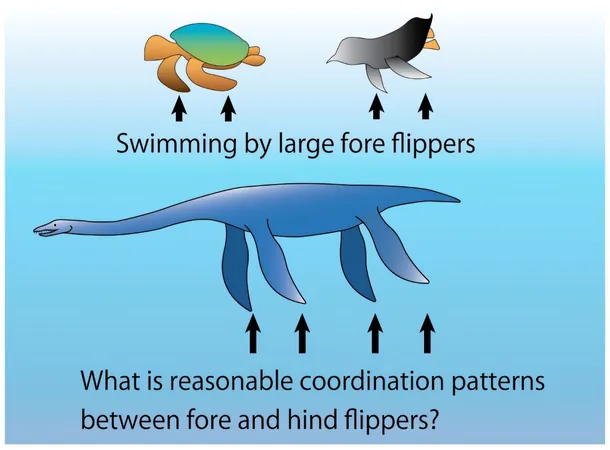
Unveiling the Secrets of Plesiosaur Swimming: A Breakthrough in Ancient Marine Biology
2024-11-05
Author: Sarah
Reconstruction Challenges
Reconstructing the locomotion of extinct animals like the plesiosaur is no easy feat. Their body structures vastly differ from contemporary species, complicating efforts to understand their movement through comparative analysis. Furthermore, fossil records typically fail to preserve the soft tissues, such as muscles and ligaments, crucial for studying motion and lifestyle insights.
The Four-Wing Problem
Plesiosaurs, known for their distinctive morphology featuring four large, similarly sized flippers, have puzzled paleontologists for years regarding how they navigated their watery domains. This long-standing mystery, referred to as the 'four-wing problem,' has sparked intense debate within the scientific community.
A Revolutionary Approach
However, a team of researchers from Tohoku University, Kanagawa University, and the University of Manchester has taken a revolutionary approach to examine this issue. Instead of merely analyzing the hydrodynamics of plesiosaur bodies, they shifted focus to the control mechanisms behind their locomotion.
Inspired by Modern Mammals
Our research aimed to understand how plesiosaurs managed to swim effectively in various conditions and at different speeds,” explains Akio Ishiguro, a professor at the Research Institute of Electrical Communication (RIEC) at Tohoku University. By drawing inspiration from the inter-limb coordination seen in modern four-legged mammals like dogs and cats, the researchers developed an autonomous control system tailored for a plesiosaur-like robot.
Experimental Results
The experimental results indicate that this control system can successfully produce coordinated swimming patterns amongst the fore and hind flippers, effectively adapting to fluctuations in motion and form. “This innovative approach offers a new way to reconstruct how extinct animals might have adjusted their movements in response to their environments,” states Akira Fukuhara, an assistant professor at RIEC and the paper's lead author.
Future Research
Involved in the study alongside Ishiguro and Fukuhara were several talented researchers, including Mutsutoshi Sato and Hisayuki Ogawa, former graduate students at RIEC, Tamaki Sato, a professor at Kanagawa University, and William Sellers from the University of Manchester.
Looking Ahead
Looking forward, the research team expresses excitement about refining their models to consider additional aspects of plesiosaur anatomy. “Plesiosaurs had notably elongated necks, and the variation in neck length among different species presents another puzzle to solve,” Ishiguro adds. By integrating the dynamics of the neck, head, and torso into their motion models, the researchers aim to create a comprehensive understanding of how these ancient giants maneuvered through their marine habitats.
Conclusion
This innovative research not only propels our understanding of the plesiosaur's swimming techniques but also ignites curiosity about the myriad mysteries hidden within our planet’s ancient oceans. The quest to decode the lives of these magnificent creatures has only just begun—stay tuned for upcoming revelations!




 Brasil (PT)
Brasil (PT)
 Canada (EN)
Canada (EN)
 Chile (ES)
Chile (ES)
 España (ES)
España (ES)
 France (FR)
France (FR)
 Hong Kong (EN)
Hong Kong (EN)
 Italia (IT)
Italia (IT)
 日本 (JA)
日本 (JA)
 Magyarország (HU)
Magyarország (HU)
 Norge (NO)
Norge (NO)
 Polska (PL)
Polska (PL)
 Schweiz (DE)
Schweiz (DE)
 Singapore (EN)
Singapore (EN)
 Sverige (SV)
Sverige (SV)
 Suomi (FI)
Suomi (FI)
 Türkiye (TR)
Türkiye (TR)